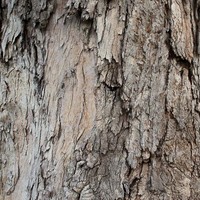Common name: Red mahogany
Other common names: Kino eucalyptus, Kino gum, Red messmate, Red stringybark
Description
Red mahogany is a large eucalyptus timber tree originating in Australia, where it occurs naturally in open forests and woodlands on the east coast of the continent.
It may reach heights of 45 m (100 ft) or more on favourable sites, usually with a straight trunk clear of branches for more than half the tree height supporting a moderately branched, rounded crown. The bark is rough, fissured, red-brown on young trees, becoming greyish-brown as the tree ages.
As with many eucalypts, the leaves change shape as the tree matures, with noticeable differences on seedling, juvenile and mature trees. On mature trees, they are lance-shaped with a slight curve, up to 15 cm (6 in) long, dull green and give off a resinous odour when crushed. They remain on the tree throughout the year.
The flowers are typical of eucalypts, with long white filaments set in a small goblet-shaped base. They form loose clusters of up to ten, bloom in the spring and develop, when fertilised, into small, woody, bowl-shaped seed capsules with four sharply-pointed tips. Each capsule contains small, brown, pyramidal-shaped seed.
Use
Red mahogany produces a heavy wood, averaging around 950 kgs per cubic meter (59 lbs per cubic ft), with moderate to high natural resistance to rot and decay. These properties make it a durable hardwood, suitable for indoor and outdoor construction.
The sawn timber reveals deep red-brown, closely-grained heartwood that darkens on exposure to light and air. It is prized for high-quality furniture and cabinets and is used in interior and exterior flooring and decking and heavy construction, including house-frames and railway sleepers or crossties.
The flowers are a major source of pollen and a moderate source of nectar for foraging honeybees, resulting in a pale amber honey of low density and that is slow to granulate.
Climate
Grows naturally in moderately humid subtropical and tropical mid-to high-elevation climates, generally areas with annual lows of 10 to 18°C, annual highs of 18 to 29°C, annual rainfall of 800 to 3200 mm and a dry season of 2 to 7 months, extending to 10 months with irrigation or groundwater.
Introduced long ago into India, it generally does not thrive there at elevations below 1000 m (3300 ft).
Growing
New plants are usually started from seed, which germinate readily. It performs best on free-draining clay, clay-loam and loam soils of a moderately acid to neutral nature, generally with a pH of 5.0 to 7.5, and on sites with full to partial sun exposure.
Problem features
The seed capsules are produced in great numbers. They release their seed from high on the tree, causing scattering over a wide area beneath the canopy. And the wind more widely disperses some as they fall. It is assessed as a high weed risk species for Hawaii by the Hawaii Pacific Weed Risk Assessment (HPWRA) project.
Where it grows
References
Books
-
Blake, S. T. & Roff, C. 1987, The honey flora of Queensland, 3rd ed., Queensland Department of Primary Industries (QLD DPI), Brisbane
-
Boland, D. & Brooker, I. & McDonald, M. W. 2006, Forest trees of Australia, 5th ed., CSIRO Publishing (Ensis), Melbourne
-
Clemson, A. 1985, Honey and pollen flora, New South Wales Department of Agriculture, Inkata Press, Melbourne
-
Little, E. L. & Skolmen, R. G. 1989, Common forest trees of Hawaii (native and introduced), Agricultuural Handbook No. 679, Forest Service, U.S. Department of Agriculture, Washington, D.C.
-
Little, E. L. 1974, Trees of Puerto Rico and the Virgin Islands, Vol. 2, United States Department of Agriculture (USDA), Washington D.C.
-
Porter, T. 2012, Wood : identification & use, Compact edition, Guild of Master Craftsman Publications, Lewes, East Sussex
-
Randall, R. P. 2002, A global compendium of weeds, R.G. and F.J. Richardson Press, Melbourne
-
Randall, R. P. 2007, The introduced flora of Australia and its weed status, Cooperative Research Centre for Australian Weed Management, Glen Osmond, South Australia
-
Scheffer, T. C & Morrell, J. J. 1998, Natural durability of wood : a worldwide checklist of species, Forest Research Laboratory, Oregon State University, Corvallis, Oregon
-
Streets, R. J. & Troup, R. S. 1962, Exotic forest trees in the British Commonwealth, Oxford University Press, Oxford, England
-
Webb, D. B. 1984, A Guide to species selection for tropical and sub-tropical plantations, 2nd ed., Unit of Tropical Silviculture, Commonwealth Forestry Institute, University of Oxford, Oxfordshire



